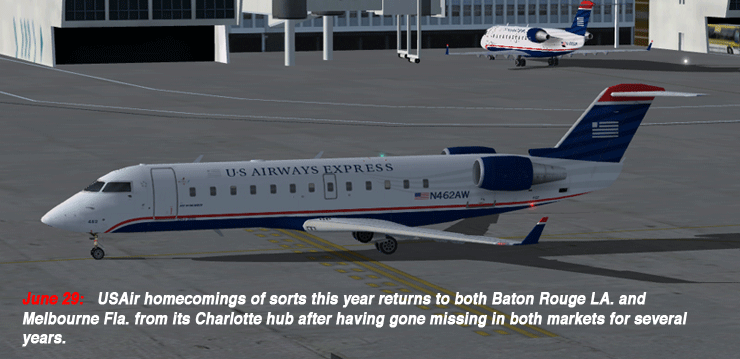U.S. House Takes
On
Air Cargo Screening
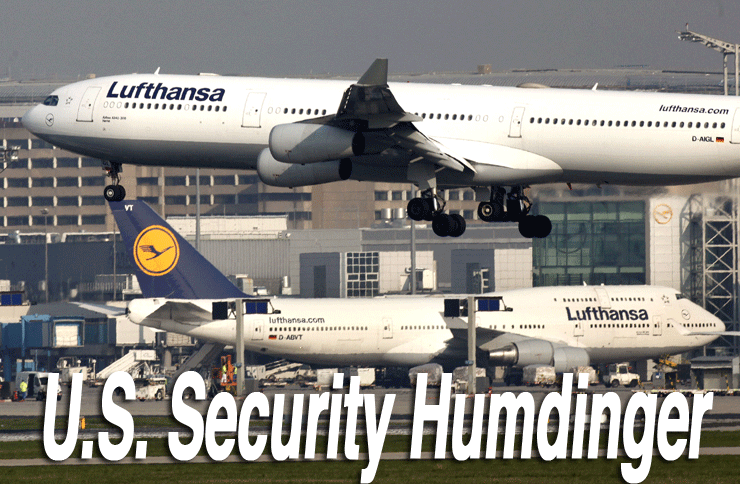
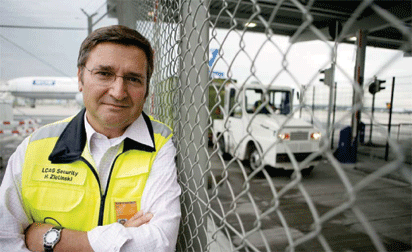 Yesterday,
Wednesday June 30, as America prepared to take a break to celebrate its
annual rite of Summer—Independence Day, on July 4th—an important
hearing held by the U.S. House of Representatives in Washington, D.C.
titled “100% Air Cargo Screening: Remaining Steps to Secure Passenger
Aircraft,” took place at 2:00 pm inside the Cannon House Office
Building. Barely a month before TSA mandated 100 percent screening of
all belly lift air cargo, the Subcommittee on Transportation Security
and Infrastructure Protection is meeting with the Subcommittee on Emergency
Communications, Preparedness, and Response to discuss these matters. Yesterday,
Wednesday June 30, as America prepared to take a break to celebrate its
annual rite of Summer—Independence Day, on July 4th—an important
hearing held by the U.S. House of Representatives in Washington, D.C.
titled “100% Air Cargo Screening: Remaining Steps to Secure Passenger
Aircraft,” took place at 2:00 pm inside the Cannon House Office
Building. Barely a month before TSA mandated 100 percent screening of
all belly lift air cargo, the Subcommittee on Transportation Security
and Infrastructure Protection is meeting with the Subcommittee on Emergency
Communications, Preparedness, and Response to discuss these matters.
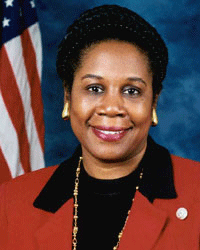 The
Hon. Sheila Jackson-Lee (D) Texas, Chairwoman of the Subcommittee on Transportation
Security and Infrastructure Protection and other lawmakers heard presentations
from invited witnesses, including the TSA’s John Sammon, U.S. GAO’s
Stephen Lord, ATA’s CEO John Meenan and three air cargo industry
executives, including Mike Middleton, EVP of Secure Global Logistics and
Fernando Soler, CEO of S.O.S. Global Express. The
Hon. Sheila Jackson-Lee (D) Texas, Chairwoman of the Subcommittee on Transportation
Security and Infrastructure Protection and other lawmakers heard presentations
from invited witnesses, including the TSA’s John Sammon, U.S. GAO’s
Stephen Lord, ATA’s CEO John Meenan and three air cargo industry
executives, including Mike Middleton, EVP of Secure Global Logistics and
Fernando Soler, CEO of S.O.S. Global Express.
But in a genuine first comes the remarkable appearance of Lufthansa German
Airlines Head of Security and Environmental Management, Harald Zielinski,
to speak as featured witness in front of these august members of the U.S.
HOR.
Herr Zielinski is the first foreign national
to be invited by the U.S. Congress to testify about air cargo security.
It also needs to be pointed out right away
that Harald delivered the goods.
It’s worth recalling that in 2007,
Congress mandated that the Transportation Security Administration must
screen 100 percent of all cargo carried by passenger planes by August
2010.
With that deadline now looming just a month
away —and the total-screening goal far from being achieved—U.S.
lawmakers (to their credit) have expanded their search for answers by
searching out the best and the brightest to try and get some solid forward
movement.
Bringing in Zielinski, the top security
executive from an airline that is delivering 100 percent total screening
to its USA air cargo product starting on July 1 (more than a month before
the TSA mandate) therefore makes good sense.
But what is right and sensible does not
always happen, so score a major goal for air cargo this day in Washington,
D.C.
Mr. Zielinski, who came to his post as a
former policeman from the streets of Frankfurt (just like his father before
him), is, among other things, one tough cop. He is plain spoken and totally
dedicated to getting things right, and doesn’t seem to take anything
for granted.
Right now, most experts agree that the reality
of the 100 percent security screening mandate is still complicated by
determining and certifying the right technologies and obtaining compliance
from other nations.
Faced with the fact that the U.S. Congress
is highly unlikely to repeal the 100 percent mandate altogether, many
feel that TSA must find a workable solution that meets the mandate in
the near future.
It is believed that TSA needs more flexibility
so it can accommodate both security and supply chain realities.
Mr. Zielinski took the bull by the horns
and was thoroughly professional, driving home his points in this unique
public forum situated at the highest levels of USA government.
Here are his comments:
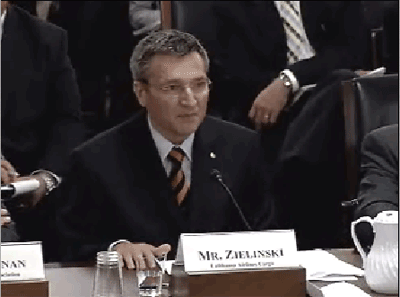 “There are several key aspects of
the 100 percent screening requirement and further identifying steps towards
‘smart security.’
“There are several key aspects of
the 100 percent screening requirement and further identifying steps towards
‘smart security.’
“Based on Lufthansa Cargo’s
experience, TSA has done an outstanding job of developing and communicating
about the CCSP and ensuring that air cargo stakeholders are aware of the
pending August 1 deadline for 100 percent screening of U.S. origin cargo.
“In some cases, the confidential security
measures, as a result of this mandate, were not communicated with sufficient
notice. We are unclear about how TSA will proceed with measures relating
to foreign inbound cargo.
“Finally, we believe more could be
done to evaluate cargo screening technologies and to foster the development
of applied training to support the effectiveness on use of the technologies.
“Cargo security is an uncompromised
priority and purposeful investment at Lufthansa Cargo.
“All of our airport stations in the
United States are equipped with self-owned security equipment consisting
of explosive trace detection equipment and large aperture, advanced-technology
x-ray systems at our gateway stations.
“When Congress passed the Implementing
Recommendations of the 9/11 Commission Act of 2007 into law, mandating
100 percent cargo screening onboard passenger aircraft in the United States,
Lufthansa Cargo adopted a comprehensive strategy.
“This was supported immediately by
our executive board and senior leadership. For Lufthansa Cargo, the requirement
to screen 100 percent did not simply apply to screening alone, but also
required changes to our operations, resource allocation, productivity
and processes.
“We directed extensive funding to
our United States operations for the investment in technology and the
cost for increased resources.
“As our business is in the service
sector, it is reliant upon our customer base. Integral to this strategy
was establishing an effective communication campaign to promote awareness
of the mandate.
Need For Readiness
“The key to this communication was
to ensure an understanding by our customers on the need for readiness.
Lufthansa Cargo initiated and hosted two security conferences in New York
in 2008 and 2010, bringing together our industry partners and customers,
academia and U.S. government representatives to address the increased
regulatory framework in the United States. Additionally, we led two security
conferences in Germany, which included representatives from TSA, in order
to continue the outreach plan on the U.S. and EU regulatory frameworks
and the need for harmonization of security measures.
“A tremendous effort has been incorporated
into our business plan to ensure the mandate is accomplished successfully.
“It is important to highlight that
these measures were adopted when the economic climate in 2009 was focused
on business survival.
“I am very proud to report to you
that these extensive efforts by Lufthansa Cargo will allow us to achieve
the screening mandate in the United States one month early, effective
July 1st, 2010.
“Albeit a massive challenge, considerable
resources, money and time were allocated to adopt and carry out this strategy
effectively and to ensure a robust business continuity plan.
“We commend TSA on its robust communication
effort within the United States to increase public awareness and understanding
of the mandate.
“This included various road-shows,
public outreach seminars and webinars to address the dynamics of the regulation
and the operational challenges to industry.
“We also acknowledge TSA’s extensive
efforts in developing and allowing industry to adopt a key tool for the
success for this mandate within the United States, the Certified Cargo
Screening Program (CCSP).
"This program, although still in its
infancy, is critical to ensure all partners share in the screening effort
to maintain commercial flows, close-out times and to limit facility and
airport congestion. We would encourage TSA to continue the outreach on
the CCSP and invigorate the program beyond August 1st, 2010.
"We further commend TSA in meeting
with specialty shippers in the pharmaceutical and sensitive goods markets
to encourage adopting a plan to ensure the flow of commerce within these
markets is not impeded.
"Although TSA has been effective in
its communication plan regarding the 50 percent and 100 percent milestones,
intermediary milestones for both U.S. and foreign origin cargo were mandated
without industry consultation and without adequate notice effective May
1st, 2010.
"Lufthansa Cargo had strategically
aligned our budgets, resource scheduling and technology delivery schedules
based on the initial mandates.
"In the future, we would encourage
TSA to engage industry as expeditiously and extensively as possible in
order to fulfill any necessary incremental requirements.
"While we recognize that TSA is responsible
for developing the regulatory protocols, it is critical for industry to
be well informed in order to best execute these regulations on multiple
complex operational and management levels.
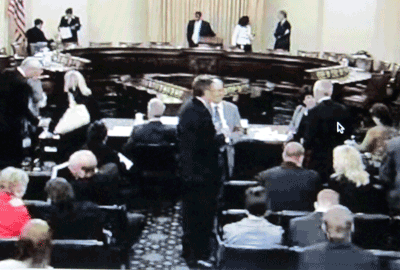 "TSA has communicated openly regarding
the concerns and necessary policy adaptations to properly address 100
percent screening of cargo onboard passenger aircraft inbound to the United
States.
"TSA has communicated openly regarding
the concerns and necessary policy adaptations to properly address 100
percent screening of cargo onboard passenger aircraft inbound to the United
States.
"However, we are not certain of TSA’s
timetable for implementing 100 percent foreign inbound screening, of any
additional interim regulatory steps it may take, or of the process by
which TSA is engaging other governments to assess and recognize their
security programs and factor this into compliance for foreign inbound
shipments.
"Due to the complexities of the air
cargo industry, we must look beyond a 'one-size fits all' approach to
security.
"It is critical that measures fulfilled
under foreign programs that meet or exceed the measures anticipated by
TSA be fully assessed and evaluated for mutual recognition.
"We are a global company operating
in a global industry, and duplication and redundancy in implementing multiple
country specific cargo security efforts would impede the flow of commerce,
create unnecessary costs and diminish efficiencies within supply chains.
"In the air freight market, we need
to deliver products today, not tomorrow.
Harmonization Of
Policies
"We commend TSA for recognizing the
complexity of the international air freight market and the need to address
the 100 percent inbound criteria with legitimate prudence to preserve
trade and commerce among global partners, and we stand ready to engage
in an active dialogue with TSA on this subject.
"The security policy of Lufthansa Cargo
is based on risk management. Furthermore, our implementation of the European
Union framework and the German Aviation Security plan provides a robust
regulated environment for air cargo that has and continues to develop.
"The German Aviation Security Program
and the newly released European Union Framework 300, Rule 185, is a comprehensive
program that mirrors the basic fundamentals of the TSA regulatory programs
for U.S. origin flights.
"The basic fundamentals implemented
thus far in the U.S. are currently mandated or underway for development
within the European Union and each respective member state.
"In some areas these programs exceed
TSA’s requirements, such as in the areas of access control and employee
screening prior to entering the secure area.
"General EU requirements have adopted
a structure with the regulated agent and certified consignor that is of
similar content and requirements of the TSA recognized indirect air carrier
and known shipper who conducts screening under the CCSP program.
"Any entity in the EU issuing the security
status of a shipment must be a regulated agent approved by the national
competent authority.
"A known consignor within the EU must
apply and be subject to site-specific audits by the national competent
authority.
"Additionally, road feeder service
providers must also have a regulated status with the authority or be contractually
connected to the regulated agent or airline.
"Although we understand and respect
that within the regulations imposed by TSA the airline is the regulated
entity, we are not in a position to directly address the international
challenges and concerns which require a 'government to government' dialogue
and engagement on the issues.
"We strongly encourage this official
communication to be expedited between TSA and each member state within
the EU to discuss the existing security measures that are currently applied
in the U.S. and respective member state.
"TSA needs to adopt an international
policy and program whereas protocols are developed and communication is
strengthened.
"As TSA has provided the tools necessary
to complete the outbound-U.S. screening requirement and have further indicated
that the
"CCSP program is critical in meeting
the 100 percent mandate in the U.S., such tools are imperative overseas
in the area of mutual recognition in order to achieve the same level of
success.
"Lufthansa Cargo looks forward to work
in continued collaboration with government and industry in the development
of future security measures as they evolve or change with the continuous
assessment of risks.
"In the effective approach to define
risk, we recognize government to assess the threats; whereas industry
can elaborate when it comes to realizing vulnerabilities and business
consequence modeling.
"At Lufthansa Cargo we constantly review
and evaluate the need for future security enhancements.
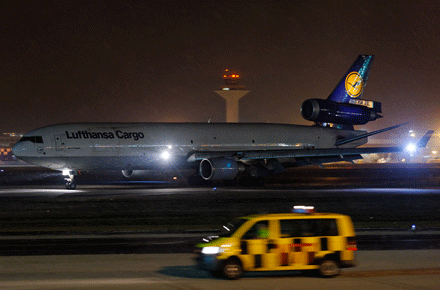 "We look forward to the opportunity
to address a robust, comprehensive security program based on the supply
chain and not based on the type of aircraft flown.
"We look forward to the opportunity
to address a robust, comprehensive security program based on the supply
chain and not based on the type of aircraft flown.
"As to technology for air cargo screening:
We appreciate and recognize the requirements in the Implementing the 9/11
Recommendations Act of 2007 that cargo must be screened to ‘commensurate
with checked baggage’, however, the fact remains that cargo does
not have the same characteristics as checked baggage.
"Cargo consists of bulk packaging,
odd sizes, various commodities and sensitivities that require enhanced
technology.
"This would include the requirement
to use larger aperture x-ray use beyond the current restrictions, expanded
research on the use of trace detection applications and the further recognition
of international canine teams.
"Lufthansa Cargo believes that based
on our experience in dealing with millions of kilograms and hundreds of
flights weekly we urge TSA to evaluate the need for requiring complicated
screening percentage evaluations and manually reported data.
"'Smart security' depends upon the
responsible allocation of justified resources to order to invoke the most
efficient flow of operations while maintaining a balanced and reliable
security environment.
"Lufthansa Cargo has instituted best
demonstrated practices for our security operation in the area of operational
testing and training.
"In working closely with manufacturers
we are extensively evaluating and field testing new technologies in Europe
and the United States.
"Operational testing is critical to
evaluate the real life challenges demanded of our industry and the complexity
of cargo commodities and packaging.
"When evaluated outside the laboratory
environment, the expansion of use for the technologies can be effectively
realized.
"We urge TSA to bolster and expand
field testing of large aperture screening technologies in order to address
current restrictions.
"Equally, training is critical in order
to effectively operate equipment and carry out security requirements.
Lufthansa Cargo is confident that our training programs surpass any previous
industry benchmark and believes that effective training will demonstrate
effective security.
"Currently there is a tremendous disparity
within the industry on how training and subsequent testing is developed
and disseminated to the operational staff and representatives. We would
welcome any opportunity to review these standards with TSA to develop
a stronger framework for the industry.
"Through our existing partnerships
with TSA in exploring effective freighter screening technologies and the
early evaluation stages for the CCSP program, we look forward to other
areas of collaboration where we can find suitable solutions for the extremely
complex environment that poses such significant challenges.”
It is pretty clear that Herr Zielinski was
more than capable of delivering the necessary information while also addressing
strategies for the future. His thorough and exact commentary is just what
is needed at this time in dealing with the complex matter of screening,
especially in this heightened political climate. The honor of meeting
with the U.S. House of Representatives, and of representing the cargo
community, could not have fallen on a more deserving individual. We here
at Air Cargo News FlyingTypers are confident that change is coming,
and it is good.
Other Voices
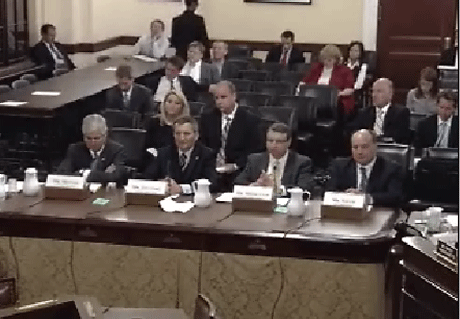 So
with the Lufthansa Cargo position on 100 percent compliance to TSA mandates
clear, including the questions directed back to the government panelists
(mostly unanswered), the burning question of whether 100 percent belly
lift screening will be met was addressed by other witnesses. So
with the Lufthansa Cargo position on 100 percent compliance to TSA mandates
clear, including the questions directed back to the government panelists
(mostly unanswered), the burning question of whether 100 percent belly
lift screening will be met was addressed by other witnesses.
Stephen Lord
Director of Homeland Security and
Justice Issues
U.S. Government Accountability Office
Stephen Lord, Director of Homeland Security
and Justice Issues for U.S. Government Accountability Office (GAO), noted:
“To achieve TSA’s ideal mix
of screening by August 2010, shipper and independent CCSF screening efforts
would need to increase by over sixteenfold (from today, June 30).
“The total percentage of reported
screened cargo rose on average by less than a percentage point per month
(from 59 to 68 percent) from February 2009 through March 2010.
“At these rates, it is questionable
whether TSA’s screening system will achieve 100 percent screening
of domestic cargo by August 2010 without impeding the flow of commerce.
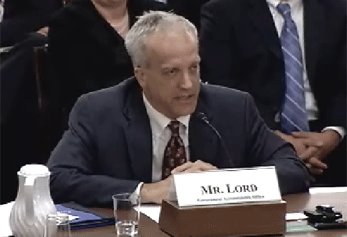 “Effective
May 1, 2010, TSA requires that 75 percent of air cargo transported on
passenger aircraft be screened. “Effective
May 1, 2010, TSA requires that 75 percent of air cargo transported on
passenger aircraft be screened.
“However, even if this requirement
is met, an additional 25 percent of domestic air cargo would still need
to be screened in the 3 months prior to the August 2010 deadline, including
some of the most challenging types of cargo to screen, such as unit load
device (ULD) pallets and containers.
“TSA and industry officials reported
that several factors, such as lack of economic and regulatory incentives,
are contributing to low shipper participation levels.
“TSA and the domestic passenger air
carrier and freight forwarder industry association officials we interviewed
stated that many shippers and freight forwarders are not incurring significant
screening costs from air carriers.
“This decreases the financial pressure
on the entities to join the CCSP and invest resources into screening cargo,
factors that are making TSA’s outreach efforts more challenging.”
John Meenan, Executive
Vice President and Chief Operating Officer Air Transport Association of
America
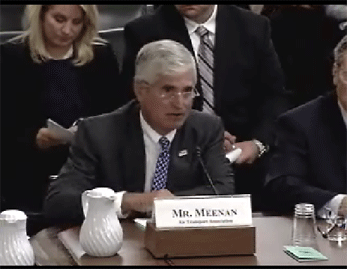 John
Meenan, Executive Vice President and Chief Operating Officer Air Transport
Association of America, Inc., said: John
Meenan, Executive Vice President and Chief Operating Officer Air Transport
Association of America, Inc., said:
“The biggest challenge in meeting the August 2010 deadline
continues to be the lack of certified screening technology to inspect
large air-cargo pallets.
“Most pieces of cargo transported on wide-body aircraft are
consolidated into large shipments, and 75 percent of cargo is transported
on wide-body aircraft.
“That fact gives you an idea of the magnitude of the challenge
that we face.
“Shippers and freight forwarders typically
create these pallet-size shipments before they are tendered to an airline.
“The challenge has always been that
screening is required at the individual carton level.
“Existing technology cannot screen
large consolidated shipments.
“The nature of our business and available
screening equipment continue to be badly mismatched.
“We identified this challenge when
we testified before this subcommittee last March, and the situation remains
unchanged.
“While the Certified Cargo Shipper
Program (CCSP) is helping to address this problem, by implementing screening-protection
upstream, a far more practical solution remains to be found with the eventual
TSA certification of screening technology that is compatible with the
cargo that we carry.
“Breaking down consolidated shipments
at an airport cargo facility is not practical.
“Shipment size, time constraints and
facility limitations are the main difficulties.
“Dismantling an air-cargo pallet or
unloading a container and screening each piece would result in the significant
disruption of air commerce. “Airport cargo facilities and ramps
were not designed to be high-volume disassembly and reassembly locations,
and are not big enough to perform that role, especially at peak times.
“A better alternative must be found.”
Mike Middleton,
Executive Vice President, Secure Global Logistics
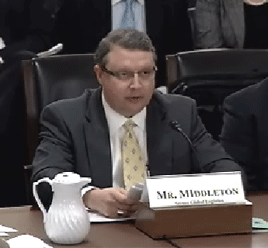 Mike
Middleton, Executive Vice President at Secure Global Logistics, a Texas
based multi modal company, noted that his company was an early adopter
of TSA’s screening program. Mike
Middleton, Executive Vice President at Secure Global Logistics, a Texas
based multi modal company, noted that his company was an early adopter
of TSA’s screening program.
“We were initially certified as a
cargo screening facility prior to the February 2009 50 percent screening
requirement.
“We subsequently applied for and were
accepted into TSA’s Pilot Program and received grants enabling us
to procure AT X-Ray equipment and Trace Detection equipment.
“We have been screening at the 100
percent level since February 2009, first using manual inspection techniques
and later utilizing X-Ray and Trace technologies provided by TSA reimbursement.
“Funding from TSA as a pilot program
participant was the key for our company to bring technology to bear on
the screening process.
“Ours is a low margin industry and
capital funding for non-revenue producing services like cargo screening
would be prohibitive for companies like ours.
“In fact, in our city (Houston, Texas)
there are more than 1,000 companies similar to ours and yet less than
40 have become Certified Cargo Screening Facilities.
“Of those, I would suspect that the
majority are not purchasing technology, but only utilizing manual open
and inspect procedures in order to avoid the substantial capital investment
required to obtain screening equipment, inspection techniques and later
utilizing X-Ray and Trace technologies provided by TSA reimbursement.
“As we approach the impending August
3 mandate for 100 percent screening, facilities like ours are generally
well suited to the challenge.
“We have taken the time to become
certified for manual inspection.
“Through the Pilot Program, we have
obtained both AT X-Ray and Trace Detection equipment.
“And with a history of screening at
the 100 percent level for a year and a half, we have already put into
place the facility security requirements, conducted the required CCSF
training with our staff and certified our employees on the original equipment
from the manufacturers of the screening equipment.
“In other words, companies that have
taken this mandate seriously and who have embraced the program will be
ready.
“However, companies like ours are
in the minority.
“As mentioned previously, there are
more than 1,000 companies like ours in Houston, Texas alone.
“Yet in the entire USA there are less
than 650 Certified Cargo Screening Facilities.
“I cannot speak for all companies,
but I do know that for a company like ours, the costs of program participation
can be onerous.
“Facility security measures alone
cost us approximately $80,000.
“Training for our staff in TSA CCSF
procedures and training in the OEM equipment amounted to approximately
$20,000.
“X-Ray and Trace Detection Equipment
used in our facility totaled approximately $300,000.
“There are few companies in our industry
that can afford almost a half a million dollars of capital investment
for services that are non-revenue generating.
“Had we not obtained a grant from
TSA for the Pilot Program, we would be in the same position as many of
our colleagues who have no plans to participate in the screening program,
will only become certified in manual inspection, will outsource this service
to a third party, or simply leave it to the airlines. “
John Sammon, Assistant Administrator
Transportation Sector Network of TSA
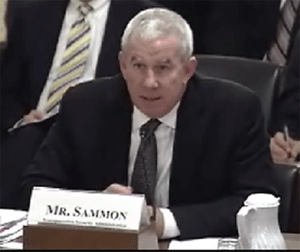 John
Sammon, Assistant Administrator Transportation Sector Network of TSA,
addressed the state of both domestic and international air cargo screening. John
Sammon, Assistant Administrator Transportation Sector Network of TSA,
addressed the state of both domestic and international air cargo screening.
“Both TSA and the air cargo industry
are ready.
“As of August 1, 2010, no unscreened
cargo will be uploaded onto a passenger aircraft departing an airport
in the United States.
“Quite simply, if it isn’t screened,
it won’t fly.
“All segments of the air cargo community
are prepared, and we expect that this will happen with little disruption.
“International inbound air cargo on
passenger aircraft is more secure than it has ever been, with 100 percent
of currently identified high-risk cargo now being screened.
“Although 100 percent screening of
all inbound air cargo cannot reasonably be achieved by August 1, 2010,
we are making substantial progress toward meeting the 100 percent mark
in the next few years.
“The centerpiece of the domestic cargo
screening program continues to be the Certified Cargo Screening Program
(CCSP), under which responsibility for the screening of cargo is distributed
throughout the supply chain to improve security while minimizing the potential
negative impact on the integrity and movement of commerce—precisely
what would happen if we allowed a screening bottleneck to occur at the
nation’s airports.
“After piloting the concept, the CCSP
was permanently established in 2009 through an Interim Final Rule. “As
of today, TSA has certified more than 760 entities as Certified Cargo
Screening Facilities, which are currently contributing over 47 percent
of the screened cargo volume (by weight) transported on passenger aircraft
departing U.S. airports.
“These entities have reported that
they already have capacity to screen nearly the entire remaining unscreened
volume as we approach the August 2010 deadline, if it becomes necessary.
“With respect to movement of international
air cargo, TSA has consistently indicated in many settings, including
in prior testimony before this Subcommittee, the challenges presented
by the international setting have made it unlikely that Congress’s
ambitious schedule for 100 percent screening could be met with respect
to inbound air cargo.
“The genesis of the challenge is simple:
an estimated 2.8 billion pounds of air cargo arrives on passenger aircraft
from 94 different sovereign nations annually via a global air cargo supply
chain with a vast number of participants.
“Those 94 nations have unique air
cargo security programs and regulatory requirements, many of which differ
significantly from those required by TSA.
“Accordingly, TSA’s approach
to international inbound air cargo must necessarily be flexible and diplomatic.
“We have been pursuing many options
that have already significantly increased the security of inbound air
cargo and are finalizing a strategy for achieving 100 percent screening.”
Fernando Soler, Owner, SOS Global
Express
 Fernando Soler, Owner, SOS Global Express
(New Bern, North Carolina) & founder of The Air Cargo Security Alliance:
Fernando Soler, Owner, SOS Global Express
(New Bern, North Carolina) & founder of The Air Cargo Security Alliance:
“The air cargo industry is as diverse
as the shipping community it services.
“The companies that make up this industry
come in all sizes and offer ‘niche’ services as well as a
full menu of offerings from managed global transportation to warehousing,
distribution, trade compliance,
and even financial services.
“The small- to mid-size forwarder
with an entrepreneurial bent can provide equally competitive service offerings
as multi-national companies given a level playing field.
“However, TSA’s current cargo
screening regime will take away that level playing field and force the
small- to mid-size IACS to face insurmountable costs and logistical hurdles
in order to remain
in the market-place.
“For many, a 100 percent screening
mandate without federal screening centers operating at all American airports
is a threat to their very existence.
“The Air Cargo Security Alliance calls
upon Congress and the Obama Administration to fulfill the clear Congressional
intent of the 9/11 Act and protect the air cargo industry by creating
federal air cargo screening centers that will operate at all American
airports.
“As a nation committed to both homeland
security and economic growth, we must allow IACs to continue to serve
their clients and provide essential services that create hundreds of thousands
of jobs, ensure the timely delivery of essential goods worldwide and bolster
the American economy.”
Watching this meeting was fascinating, both
in the actions during testimonies and also during the breaks. It went
on for about four hours, with breaks, as committee members went off to
the US House of Represenatives to vote for various bills.
There was the feeling of a genteel civility,
as though the government officials and also the witnesses are all members
(for some, if only for a day) of the same club.
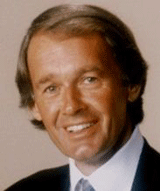 About the only action that could have been
described as confrontational was supplied by Rep. Ed Markey (D-Mass),
who is a frequent and vocal critic of TSA.
About the only action that could have been
described as confrontational was supplied by Rep. Ed Markey (D-Mass),
who is a frequent and vocal critic of TSA.
Rep. Markey, who doesn’t even sit
on the panel ,has made a career of hurling verbal fisticuffs at TSA, and
this day he aimed at a determined (if somewhat hapless) John Sammom.
Sammon did his best during the Markey diatribe
to utilize the old boxer Mohammed Ali’s tactic of allowing his opponent
to punch himself out—a move Ali called ‘ropa-dope.’
Markey finally left after not laying a glove
on John Sammon, and the discreet behaviour of the witnesses and government
panel continued.
What happens next?
Stay tuned.
Geoffrey/Flossie
|




